Wind and Sea: The Heart of Surfboarding Culture
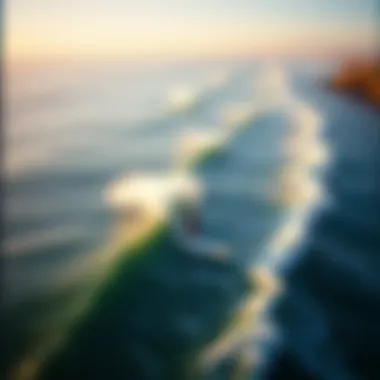
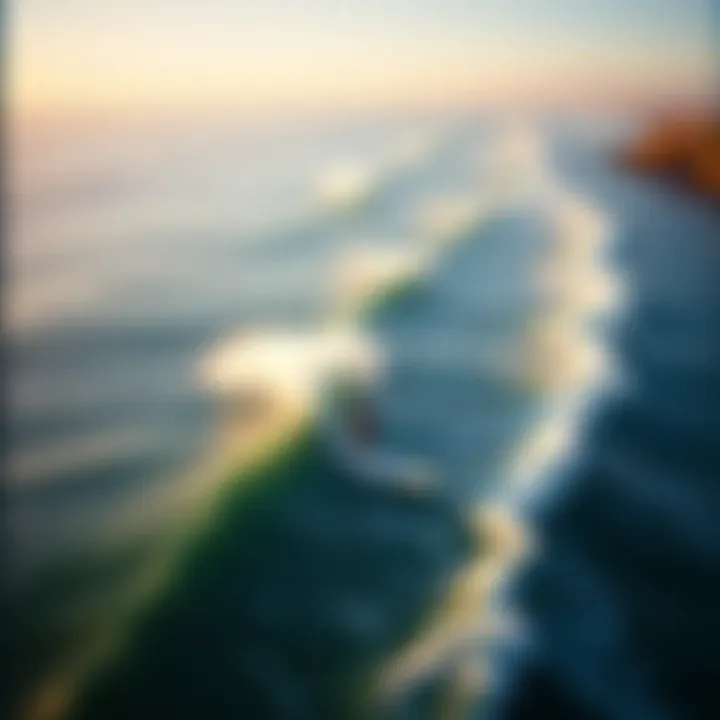
Intro
The fluid relationship between wind and sea is at the heart of surfboarding culture. For surfers, the ocean is not just a playground; it's a complex tapestry woven together by atmospheric and environmental forces. These elements dictate how waves form, how big they are, and in what direction they break. Understanding this dynamic is essential for anyone passionate about riding the waves. This article explores the intricate dance between wind patterns and sea conditions, offering valuable insights into how surfers can optimize their experience, adapt to changing environments, and cultivate a deeper connection to the ocean.
In the following sections, we will unpack various surfing techniques tailored to different skill levels and examine the broader lifestyles surrounding surf culture. By looking at surfboard crafting, environmental impacts, and how different regions worldwide embrace this sport, we strive to illuminate the ways surfing is shaped not just by the water beneath us, but the air above it as well.
Understanding Wind as an Element of Surfing
When considering the world of surfboarding, the role of wind may often be overlooked amidst the glistening waves and the thrill of riding them. However, understanding wind is fundamental to mastering this sport and maximizing the surf experience. Wind doesn’t just whip the water surface; it significantly shapes the very conditions that surfers encounter.
In this article, we will explore the critical dynamics between wind and surfboarding. Surfers must comprehend not only the science behind wind but also how it interacts with sea conditions, leading to the formation of waves. This knowledge can prove indispensable for navigating the surf scene effectively.
The Science of Wind
At its core, wind is movement in the atmosphere, generated by variations in air pressure due to the uneven heating of the Earth’s surface by the sun. It seems pretty straightforward, right? But we must dig a little deeper to appreciate its role in surfing. Wind can be categorized into several types, such as local winds, sea breezes, and trade winds, each affecting the ocean in unique ways.
When water laps up against coastal shores, the wind can create swells, which are the foundation for surfing. Essentially, wind energy is transferred to the water surface, generating waves of various heights and strengths. Stronger winds can form bigger, more powerful swells; conversely, gentle winds can lead to calmer seas with smaller, choppier waves. Understanding this basic principle helps surfers anticipate what to expect on any given day.
"Wind is the whisper of the ocean, the unseen brush that paints the canvas of the sea with waves."
Wind Patterns and Their Impact
Wind patterns are not arbitrary; they follow specific routes determined by global weather systems. These patterns dictate wave direction and size, impacting local surf conditions significantly. For instance, when wind blows consistently from one direction across the ocean, it can create uniform swells that are ideal for surfing. In contrast, shifting winds can result in unpredictable and choppy water, making surfing nearly impossible.
- Onshore Winds: These winds blow from the ocean toward the shore, often leading to disorganized waves that break closer to land. While they can create surfable conditions, they can also make them more difficult.
- Offshore Winds: Characterized by blowing from the land to the sea, these winds typically create cleaner, more sculptured waves that build better form for riding.
- Cross-shore Winds: When winds blow parallel to the shore, this can either help or hinder wave quality, depending on local topography and water currents.
Awareness of these patterns is essential for surfers. It allows them to choose the right time and place to hit the waves, enhancing their performance while reducing the risk of accidents. By reading the wind and understanding its relationship with the sea, a surfer can turn a good day of riding into an unforgettable adventure.
In summary, the dynamics of wind in surfing are profound. Recognizing how wind behaves and its effects on the sea not only enriches a surfer's experience but also contributes to safety and skill development. This knowledge also aligns with the culture of surfing, which thrives on an intimate understanding of the elements that define this exhilarating sport.
The Sea: A Multifaceted Entity
The sea is not just a body of water; it represents a complex system that plays an essential role in shaping surf culture and experiences. Understanding the sea as a multifaceted entity allows surfers to appreciate the various dynamics that contribute to their riding experience. From wave mechanics to the effects of currents and tides, the sea provides an ever-changing playground that both challenges and captivates surf enthusiasts. Conditions can shift in the blink of an eye, transforming what may seem like an ordinary day into an extraordinary adventure.
Wave Mechanics
Waves are the lifeblood of surfing, defining the very core of what it means to ride the water. Waves are generated primarily by wind as it blows across the surface, transferring energy to the water. Factors such as wind speed, fetch (the distance wind travels over water), and duration all work together to create varying types of waves. There’s a certain beauty in watching a small swell morph into towering waves, offering different opportunities for riders of all skill levels.
Surfers often talk about the "perfect wave"—a term that encapsulates the thrill of finding a wave with the right combination of size, shape, and speed.
- Constructive interference occurs when two waves meet, creating larger waves; it’s the surfer’s dream.
- Conversely, destructive interference can kill the momentum of a wave, causing it to flatten out.
The steepness of the sea floor also impacts wave behavior. A rocky, abrupt bottom might create faster, more powerful waves, while a gradually sloping beach could yield gentler, rolling swells suitable for novice surfers. It’s vital to gauge these aspects before heading out, as they will influence not only riding style but also safety.
"A well-formed wave is akin to a stage; it requires the right actors—wind, swell, and bottom contour—to perform flawlessly."
Currents and Tides
Currents and tides bring another layer of complexity to surfing. Currents can either propel surfers forward or hinder their journey. Understanding how they work is crucial for anyone serious about the sport. There are two primary types of currents that surfers need to be aware of: longshore currents and rip currents.
- Longshore currents travel parallel to the shore and can shift a surfer significantly along the beach. While they can provide an easy ride, it's essential to stay aware of your surroundings, as you may end up further down the coastline than intended.
- Rip currents, on the other hand, are the dangerous type. They pull surfboard riders directly away from the shore at potentially alarming speeds. Surfers are advised to look for signs of rip currents, such as shallow water or a section of churning foam, and should know to swim parallel to the beach when caught in one.
Tides, driven primarily by the gravitational pull of the moon, also play a crucial role in surf conditions. Some surf spots work best during high tide, while others are better suited for low tide. Timing your surf session according to the tide can make all the difference in wave quality and safety.
- Low Tide: Exposes more of the ocean floor, creating steeper waves, which can be perfect for more experienced surfers eager for a challenge.
- High Tide: Produces more mellow and crumby waves, great for beginners or longboarders cruising along.
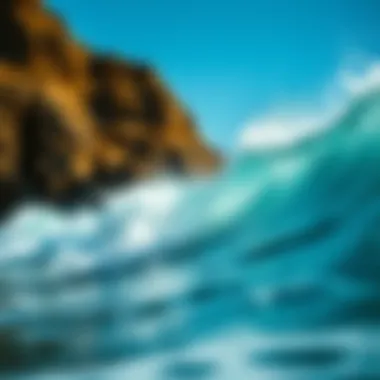
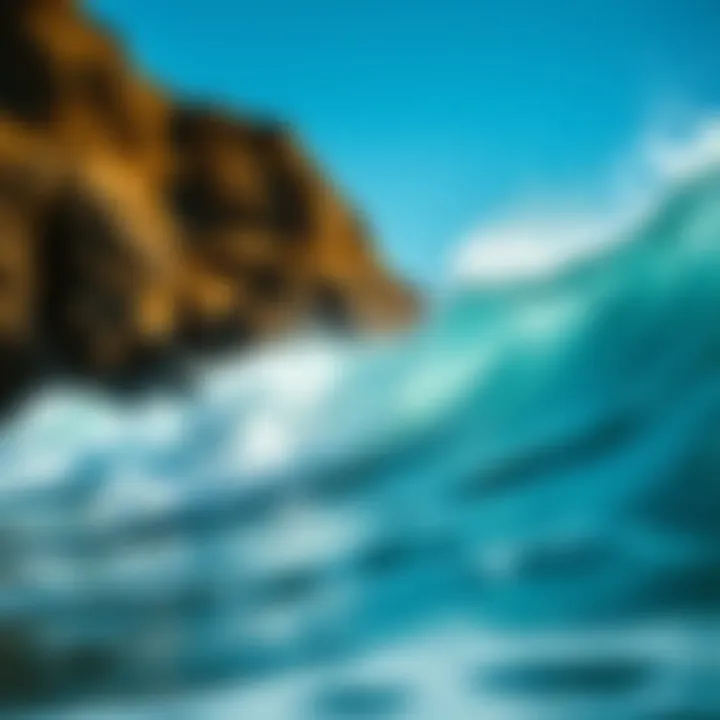
In summary, the interconnectedness of wave mechanics, currents, and tides offers an expansive canvas for surfers to explore their craft. Recognizing and understanding each aspect is not just beneficial—it's essential for thriving in this unique culture.
Interaction of Wind and Sea
The relationship between wind and sea is fundamental to the world of surfing. Understanding this interaction allows surfers not just to ride the waves but to genuinely engage with their environment. Each surfer will eventually come to appreciate how these two forces dance together, impacting everything from wave size to consistency and surf conditions. This interplay ultimately shapes one’s surfing experience, both in terms of skill development and enjoyment.
Why is this important? The rhythm of the ocean and the breath of the wind often dictate surf conditions. When surfers grasp how wind affects sea and wave dynamics, they can make astute decisions on when and where to surf. This knowledge enhances safety, promotes better performance, and fosters a deeper connection to nature.
How Wind Influences Surf Conditions
Wind does not simply play a supporting role; it is a key player in the drama of surfing. From offshore breezes that create glassy conditions to onshore winds that can wreak havoc, wind patterns are a game changer.
- Types of Winds and Their Effects:
- Wind Speed is Key: Not only the direction but the speed of the wind matters. Breezes in the range of 10 to 20 knots can help the waves stand tall. However, anything beyond that may lead to chaotic wind chop, turning a surfers’ ride into a battle against nature rather than a harmonious glide.
- Temporal Changes: Winds are fickle and can change rapidly. A session that starts with pristine conditions can quickly turn into a challenging ordeal. This unpredictability is something surfers learn to read over time, making awareness of the forecasts a routine part of their surfing ritual.
- Offshore Winds: These winds blow from land towards the sea, often creating clean waves that allow surfers to perform at their best. The waves can hold shape longer, making for a smoother ride.
- Onshore Winds: Conversely, these winds blow from the sea towards land, often leading to choppy waters and unpredictable wave breaks. They tend to disrupt wave formation, leading to a less enjoyable surfing experience.
- Cross-Shore Winds: These winds blow parallel to the shoreline and can create a mix of conditions, sometimes enhancing waves in certain spots while flattening waves in others.
Quote – "The ocean is a restless partner; understanding its language is key to riding its rhythm."
The Role of Local Topography
Wind's influences do not operate in a vacuum but rather intermingle with the local geography. The contour of the land profoundly shapes how wind interacts with the waves. Surfers often witness this relationship in practice.
- Coastline Configuration: A rocky shore can create unique wave formations as wind funnels between the land masses. Areas with bays or coves may protect surfers from harsher winds, resulting in secret spots that can attract enthusiasts away from the crowds in the open ocean.
- Sandbars and Reefs: Natural features like sandbars and reefs can amplify the wind's effect on waves. These underwater formations can lead to better breaks, allowing surfers to ride quality waves even when conditions seem suboptimal elsewhere.
- Landforms Over Time: Recognizing how the local landscape evolves over the seasons—how sediment shifts and new reefs develop—can be the difference between a dull session and an epic ride. Experienced surfers often keep their ears to the ground about these subtle changes.
- Ecological Considerations: Local flora and fauna can also provide valuable clues about wind and sea interaction. Observing bird patterns, for example, can give surfers insight into prevailing winds, helping them predict wave conditions.
By understanding these dynamics, surfers cultivate not just a skill set but a profound love for the ocean. Riding the waves becomes more than just a sport; it turns into a dialogue with nature that respects the existing harmony of wind and sea.
Iconic Surf Spots Defined by Wind and Sea
Understanding the importance of iconic surf spots goes beyond merely identifying places where waves break and wind plays. These locales are a mosaic of cultural history, local lore, and a unique set of environmental factors that transform them into meccas for surfers worldwide. Each surf destination offers its unique personality, influenced by the wind's behavior and ocean conditions, which magnificently shape the surfing experience.
Some of the core considerations include how the configuration of coastlines interacts with wind patterns and the resultant wave formation. For surfers, selecting a location is often about more than just the surf quality; it intertwines one's connection to nature, the community surrounding that spot, and the stories that resonate from those waters. Iconic surf spots can evoke nostalgia and a sense of belonging, while also representing the thrill of adventure that many seek in the sport. Let's journey through some of the most celebrated waves around the globe.
Top Global Surfing Destinations
Surfers gravitate towards certain hotspots, not just for the thrill but for the vibrancy of the atmosphere. Locations like Pipeline in Hawaii, known for its powerful, hollow waves, present unique challenges that test skill levels. The fierce wind patterns on this North Shore spot create waves that can reach heights of 30 feet during winter swells.
Similarly, Jeffreys Bay in South Africa is revered for its long, fast waves that can provide rides lasting up to 300 meters. The local culture is deeply intertwined with the ocean, fostering a community of surfers whose lives revolve around the surf conditions.
- Pipeline, Hawaii - Famous for its powerful barrels, often likened to a magician's hat.
- Jeffreys Bay, South Africa - Renowned for a right-hand point break that offers thrilling rides.
- Teahupo'o, Tahiti - Known for its heavy waves, often regarded as one of the most intense surf spots.
These destinations not only attract surfers but also inspire artistic expressions, environmental preservation, and tourism economies in their respective regions.
Hidden Gems Affected by Wind Patterns
While some iconic spots are basked in the limelight, numerous lesser-known surf breaks can offer equally rewarding experiences.
For instance, Pismo Beach, California, often overlooked in favor of more famous locales, provides consistent surf influenced by unique wind patterns. Here, surfers can find enjoyment in waves that meld with gentle onshore breezes, making it an excellent venue for both beginners and seasoned enthusiasts.
Then there's Laniakea Beach in Hawaii, often brushed aside as tourists flock to the tourist-centric beaches. The ever-changing wind can create breathtaking waves that captivate, yet it remains a spot where one may catch a wave in solitude.
- Pismo Beach, California - Offers consistent tide and wind conditions with a laid-back atmosphere.
- Laniakea Beach, Hawaii - Known for its raw beauty and often uncrowded waves that change with the wind.
These hidden gems embody the spirit of discovery, showcasing the significance of wind patterns that shape surf conditions in less-traveled areas.
Practical Techniques for Surfers
In the world of surfing, understanding the dynamics of wind and sea goes beyond mere theory. Practical techniques are essential for surfers hoping to harness the elements and enhance their performance on the water. These techniques not only equip surfers to read and react to conditions but also ensure they respect the ocean and its ever-changing nature. By developing a keen awareness of the environment, individuals can elevate their surfing experience to new heights.
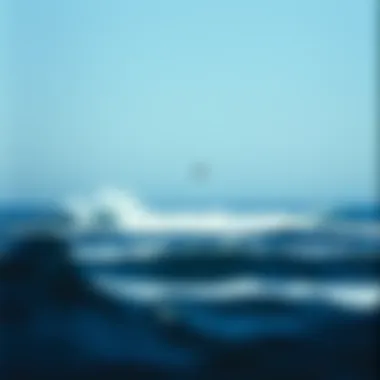

Reading Conditions
Surfers often rely on their ability to read conditions to prepare for a successful day on the waves. It’s like being a detective; you must scrutinize every clue the environment offers. Experienced surfers know to assess the shoreline, weather forecasts, and ocean activity before paddling out. Here's how to improve your observational skills:
- Check the Wind: Look at the flags or trees on shore. Offshore winds can create clean waves while onshore winds often lead to bumpy rides.
- Observe the Ocean Surface: Watch for ripples and changes in water colors. Those subtle shifts can tell you where the best waves might break.
- Wave Patterns: Understanding how waves approach the shoreline can help predict their size and frequency. Look for sets of waves and how they break; this can indicate the surf’s quality.
Adapting to Changing Weather
Weather can change faster than you can say "surfs up." It’s crucial for surfers to adapt quickly to these shifts. This means having a flexible mindset and a solid strategy:
- Stay Informed: Use weather apps or websites, but also trust your instincts and observations. The sky tells tales; a cloudy day might suggest changing winds or incoming storms.
- Embrace Flexibility: If the tide shifts or winds change unexpectedly, be ready to switch your plans. Perhaps move to a different spot or take a break and reassess.
- Communicate with Fellow Surfers: Share what you observe with others. There’s wisdom in the crowd, and experienced wave riders can provide insights you might miss.
Wind-Surfing Intersection
The borders between surfing and windsurfing aren’t as rigid as some might think. Both sports share commonalities in their relationship with wind and water. Recognizing this intersection can enrich one’s skills in both realms:
- Technique Transfer: Many surfing principles apply to windsurfing. Both require balance and an understanding of how to harness the wind. Surfers can enhance their paddling techniques by learning about sail positioning and wind direction.
- Mutual Respect for Conditions: While some surfers may view windsurfers as intruders in their territory, both groups should acknowledge how wind affects their respective sports. Being aware of each other can foster a sense of community and safety on the water.
- Joint Sessions: Sometimes the wind picks up and the waves mellow out—perfect for a windsurfing session. Transitioning from one sport to the other fosters versatility and can deepen one’s passion for the sea.
Incorporating these practical techniques can not only bolster a surfer's confidence but also enhance safety. Surfers who read conditions, adapt to weather changes, and understand the relationship between wind and water position themselves to make the most of every outing
"The ocean is a constant teacher; it offers lessons daily to those willing to listen."
By being attentive to the environment and respecting it, surfers become true beneficiaries of what wind and sea have to offer.
Cultural Significance of Wind and Sea
The relationship between wind and sea is more than a mere environmental circumstance; it serves as a cornerstone of surf culture. Understanding this cultural significance gives surf enthusiasts a richer narrative to share beyond the thrill of riding a wave or the simple joy of being near water. The collective stories, traditions, and beliefs surrounding these elements deepen the connection surfers feel to their craft and the ocean.
Surfing is inherently tied to a sense of place and identity. Many cultures have long revered the ocean and its whims, viewing the wind as a messenger of changes in surf conditions. In places like Hawaii, where surfing is not just a sport but a way of life, the wind and sea hold a sacred status. Surfers often look to the winds for omens, visualizing the frothy peaks rising in response to the breeze as a gift from nature. This cultural depth adds layers to the experience, inspiring surfers to respect the elements rather than simply exploit them, fostering a communal sense of stewardship for the water.
One cannot discount how festivals and rituals frame the culture among surf communities. For instance, events like the Maui Jim Molokai to Oahu Paddleboard Race, integrate these environmental elements as focal points, highlighting their significance in celebration and competition. Participants don’t merely compete; they pay homage to the forces that shape their sportsmanship.
Wind and Mythology in Surf Culture
The mythology surrounding surf culture often finds its roots in the wind and sea. Stories imbued with deep cultural meanings circulate among surfers, revealing how intimately these natural elements are woven into the fabric of their daily lives.
Many indigenous populations weave narratives that place deities or spirits within the wind and waves, portraying them as entities that can grant favor or bring forth turmoil. For instance, the ancient Hawaiians believed in Kanaloa, the god of the ocean, who also represented the winds. Tales of Ku and Kanaloa remind surfers of their respect for the forces they interact with; they acknowledge both the life-giving and destructive qualities that the sea encompasses.
Through these stories, surfers cultivate a kinship with the ocean, creating a spiritual connection that sustains the culture across generations.
Moreover, local surf legends become part of shared folklore. Consider stories about surfers like Duke Kahanamoku, who is celebrated not just for his prowess but as a cultural ambassador who bridged canoe culture with modern surfing through his interactions with the ocean and wind. His legacy serves as a reminder that the ocean and wind can unite and inspire.
Stories of Legendary Waves
When talking about wind and sea, there’s no shortage of legendary waves that have etched themselves into surf culture. These waves are not just revered for their height or breaking strength; each carries a narrative of the elements colliding in remarkable ways, often carrying cultural or historical significance.
For instance, Teahupo'o in Tahiti is more than just a wave; it represents the fierce power of nature. Locals revere it as a place where the ocean roars, and only the most skilled dare to ride its walls of water. Here, the wind plays a crucial role, with variable gusts influencing wave dynamics and presenting a challenge that few master fully.
Pipeline in Hawaii stands as another cultural icon. Known for its hollow, barreling waves, it also showcases how local knowledge intersects with wind patterns to determine the best surf conditions. Each swell tells stories of perseverance and skill, as surfers have deciphered the intricate dance of wind and tidal forces over decades.
Through these waves and their stories, surfers learn to appreciate not just the sport, but the artistry of nature’s design. They remind us that each ride on a wave connects us to those who came before, and those tales add profound meaning to each surfing experience.
In essence, the wind and sea create a narrative that unites surfers to their environment, giving depth to their practice and a sense of belonging to the wider community.
Environmental Considerations
Understanding the environmental aspects of surfing is crucial for ensuring the sport's sustainability and longevity. As surfers, we ride the waves shaped by the very forces of nature, making it vital to consider how our actions and climate change can impact both wind and sea conditions. Responsible surf culture promotes awareness about the effects of human activity on ocean health, encouraging surfers to be stewards of the sea while enjoying their passion.


Several specific elements merit attention when discussing environmental considerations in surfboarding culture:
- Impact of Climate Change: Changes in climate are not just headlines; they directly affect the conditions we surf in. Rising global temperatures lead to warmer oceans, which affect wave patterns, sea levels, and even hurricane activity. With shifting weather systems, familiar spots may become less reliable, altering the local surfing landscape.
- Ecosystem Integrity: The health of marine ecosystems, including coral reefs and coastal habitats, is inextricably linked to surfing. These environments buffer shorelines from storms and provide crucial habitat for diverse marine life. A decline in these ecosystems can lead to weaker waves and a disconnection in the surf community's connection to nature.
- Pollution Awareness: Pollution, both from land and water sources, poses a significant threat to surfers and the waves they ride. The presence of single-use plastics, chemical runoff, and oil spills transforms our favorite surf spots into hazardous areas, diminishing not only the quality of the water but the joy of riding those waves.
To raise awareness of these pressing issues, surfers can serve as ambassadors for environmental stewardship, working both individually and collectively to mitigate their impact on the ocean. This calls for a mindset that balances personal enjoyment with advocacy for environmental health.
Impact of Climate Change on Wind Patterns
Climate change isn't just an abstract problem; it’s an urgent issue reshaping our oceans, the very canvas on which surfers create their art. As temperatures rise, so do concerns about changing wind patterns that significantly influence surf conditions. Stronger hurricanes and modified seasonal winds bring forth irregular surf days, impacting the consistency that many surfers rely on. The delicate balance that wind patterns provide can mean the difference between an unforgettable session and a flat day at the beach.
Surfers are becoming increasingly aware of these implications, adapting their practices as necessary. Knowledge about these evolving patterns allows surfers to seek alternative locations and time their trips according to expected conditions, all while advocating for sustainable measures that could help recapture some predictability in the surf environment.
Sustainable Surfing Practices
Adopting sustainable surfing practices is not merely a choice; it has become a necessity as our oceans face mounting challenges. Surfers can contribute to their beloved waves by incorporating eco-friendly practices into their routines. Here are some effective strategies:
- Eco-Friendly Board Options: Consider investing in surfboards made from sustainable materials, like paulownia wood or recycled foam. Many surfboard companies are now prioritizing eco-conscious design over conventional methods that may harm the environment.
- Avoiding Plastic Waste: Bring reusable water bottles and avoid single-use plastics like straws or bags. This small change can significantly reduce pollution, making a lasting impact on the health of our beaches and oceans.
- Participating in Beach Clean-Ups: Engage with local surf clubs or environmental organizations to take part in community-driven beach clean-up efforts. These events not only benefit the ocean but also foster a sense of camaraderie among surfers.
- Educating Others: Share knowledge about environmental issues with fellow surfers, be it through blog posts or social media. Providing insights can spark discussions that lead to action.
As surfers ride the waves, remembering the delicate connection between the ocean and the elements that shape them is vital. The future of surfing and the health of our oceans rely on informed and sustainable practices that honor the environment.
The Future of Surfing with Changing Conditions
As the tides of change roll in, surfers are increasingly challenged to adapt to the evolving dynamics between wind and sea. This relationship, once predictable, now seems to be in flux due to various environmental factors. The future of surfing lies not only in understanding these shifting conditions but also in forgeing strategies that enable surfers to thrive amid uncertainty. Key elements include learning to read new water patterns, recognizing the implications of climate change, and embracing innovations in surfboarding technology.
Adaptation Strategies for Surfers
Surfers must be proactive to remain in tune with their environment. Here are some tailored adaptation strategies to consider:
- Location Selection: It’s essential to identify and frequently reassess surf spots. Not all beaches will see the same changes in condition, but many well-known surf spots may shift in quality as sea levels rise and coastal erosion begins.
- Training and Skills Improvement: Surfing can be more than just a pastime – it can evolve into a survival skill. Building strength, agility, and adaptability on the board helps in handling unfamiliar conditions. Taking courses or workshops on specific techniques could aid in improving response to changing waves.
- Community Engagement: Being part of a local surf community provides vital insights into recent changes in water behavior. Regular dialogue with fellow surfers can equip one with first-hand information, and it’s never a bad idea to share knowledge.
- Real-time Monitoring: Utilizing apps and platforms that provide up-to-date surf conditions can make all the difference. Local weather updates and tide charts help surfers make informed decisions every time they hit the water.
“Surfers must treat potential risks as part and parcel of the sport, reshaping their approach to be more adaptable and responsive.”
Innovations in Surf Equipment
With the tides of change affecting wave patterns and surf conditions, surfboard design is also evolving. Innovations in surf equipment are crucial to meet the demands of uncertain conditions. Here are some noteworthy trends:
- Eco-friendly Materials: Many manufacturers are exploring sustainable materials, such as bio-resins and recycled foam, which not only lessen environmental impact but also provide surprising performance benefits. These materials often enhance buoyancy and durability.
- Smart Technology Integration: The development of smart surfboards that feature sensors to analyze the surf environment offers real-time feedback. Surfers can glean insights on wave speed, height, and even their own performance metrics, allowing them to adjust techniques on-the-fly.
- Adaptive Designs: Boards are now designed to be more versatile, able to cut through choppy water or perform better in less-than-ideal conditions. For instance, tighter rocker profiles can help with control during unpredictable swells.
- Safety Innovations: More focus has been placed on safety in surf equipment design. Innovations such as impact-resistant materials and integrated flotation devices are enhancing safety measures for surfers tackling challenging environments.
As these changes unfold, the surf culture adapts. From novices riding their first waves to seasoned professionals navigating nature’s whims, the community's blend of tradition and innovation offers a unique resilience.
Through understanding the intricacies of wind and sea and adapting accordingly, surfers can forge a brighter, more adventurous future. The crucial takeaway is that while the ocean's personality may change, the spirit of surfing can remain stronger than ever.
The End: The Unbreakable Bond
As the waves clash against the shore, the essence of surfboarding culture becomes a rich tapestry woven from the elements of wind and sea. The connection between these two forces is not merely physical, but deeply ingrained in the hearts and minds of surfers around the globe. In this article, we have explored the myriad ways in which wind patterns and oceanic conditions converge, offering surfers the raw elements they crave. Understanding this bond isn't just about catching that perfect wave; it's about fostering a respect and appreciation for nature itself.
The compelling relationship between surf culture and environmental dynamics can’t be overstated. Surfers are often regarded as guardians of the sea, aware of how changes in climate can impact their beloved sport. As these systems evolve due to climate fluctuations, so too must the surfing community adapt to maintain their connection with the ocean. This section provides an opportunity to reflect on what it means to ride the waves typified by their local winds, ultimately emphasizing the necessity of environmental stewardship for the sustenance of surfing culture.
Reflections on Wind and Sea
The Call of the Ocean
When surfboards glide across the surface, they respond to the siren song of the ocean. This call is more than just an invitation to ride waves; it is a beckoning to embrace a lifestyle deeply rooted in nature's rhythm. The call of the ocean speaks to a surfer's spirit, a yearning for adventure that intertwines with the unpredictable forces of nature. The overarching characteristic of this call is its pull towards freedom—the freedom to explore, to push boundaries, and to exist within the moment.
Moreover, the ocean is a teacher. It imparts valuable lessons in humility and resilience. Every surfer knows that not every session will yield the ideal waves; some days are calm, while others unleash a tempest. This duality shapes the surfer's character, influencing how individuals interact with both the water and the world surrounding them. The key feature of this calling lies in its promise: the ocean rewards persistence with unforgettable experiences and insights.
Embracing the Elements
To truly partake in the surfing experience, one must not only hear the call of the ocean but actively embrace the elements that accompany it. Wind is an ever-present character in this tale, shaping each ride and impacting the sea's demeanor. Surfers who learn to understand and adapt to these elements can ensure safer, more enjoyable rides.
Embracing the elements entails recognizing their power and unpredictability. Winds can make or break a surfing day; on one hand, favorable winds set the stage for perfect waves, while on the other, gale-like gusts can lead to treacherous conditions. Each surfer must cultivate an instinctual understanding of these environmental nuances. Knowledge of local weather patterns and their effect on wave behavior becomes essential. That said, this dynamic relationship can forge resilience, compelling surfers to grow more attuned to nature’s varying moods.
"The sea is the great equalizer, uniting all who venture into its embrace, regardless of skill or experience."















